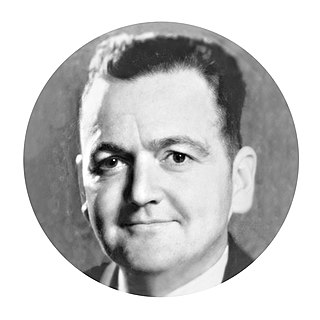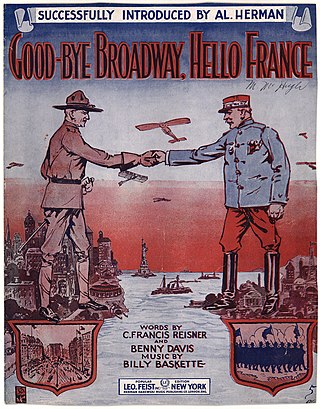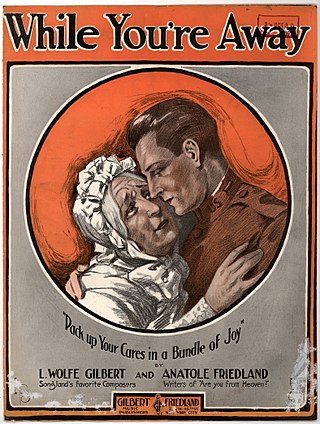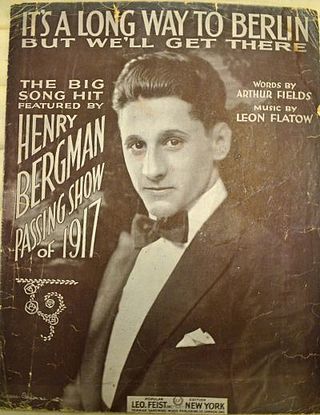
Howard Johnson was a song lyricist. He was inducted into the Songwriters Hall of Fame in 1970.

"Au Revoir, but not Good Bye: Soldier Boy" is a 1917 song composed by Albert von Tilzer, with lyrics written by Lew Brown.

Good-Bye Broadway, Hello France is a 1917 song composed by Billy Baskette, with lyrics written by C. Francis Reisner and Benny Davis. The song was published by Leo Feist, Inc.

The cover has George Washington, Betsy Ross, and her helper.

While You're Away (Pack Up Your Cares in a Bundle of Joy) is a World War I song released in 1918. L. Wolfe Gilbert and Anatole Friedland composed the music and lyrics. It was published by Gilbert & Friedland Inc. The song was performed by Harry Ellis; and also by The Peerless Quartet. In October 1918, it reached the number five spot on the US song charts. In December 1918, the song reached a peak position of number two on Top 100 US Songs of that year.

"There's a Green Hill Out in Flanders " is a World War I era song released in 1917. Lyrics and music were written by Allan J. Flynn. Al Piantadosi & Co. of New York City. The song was written for both voice and piano.

"We Don't Want the Bacon (What We Want Is a Piece of the Rhine)" is a World War I–era song released in 1918. The lyrics were written by "Kid" Howard Carr and Harry Russell, and the music composed by Jimmie Havens. The song was published by Shapiro, Bernstein & Co. of New York City. On the cover is a soldier tearing through a large piece of bacon with his bayonet. A fearful-looking Kaiser Wilhelm II is standing on the bacon. It was written for voice and piano.

"I May Be Gone for a Long, Long Time" is a World War I era song released in 1917. It was featured in the 1917 stage production of Raymond Hitchcock and E. Ray Goetz's Hitchy-Koo. Lew Brown wrote the lyrics. Albert Von Tilzer composed the music. The song was published by Broadway Music Corp. of New York, New York. André De Takacs designed the sheet music cover. It features Grace La Rue's image blended into the clouds of an ocean scene. The song was written for both voice and piano.

"Say a Prayer for the Boys "Out There"" is a World War I era song released in 1917. Bernie Grossman wrote the lyrics. Alex Marr composed the music. It was published by Joe Morris Music, Co. of New York, New York. The sheet music cover was designed by the Starmer Brothers. It features a family praying at the dinner table. Behind them is a sentry guarding a campground of tents. There is an inset photo on the left side that varies per edition. The song was written for both voice and piano.

"I Don't Want to Get Well" is a World War I era song released sometime between 1917 and 1918. Harry Pease and Howard Johnson wrote the lyrics. Harold Jentes composed the music. Leo Feist, Inc. of New York City published the song. Rosenbaum Studios designed the sheet music cover. It features a Red Cross nurse checking the pulse of a wounded soldier as he lies in his hospital bed. The two look at each other longingly. A battle is seen through the window. It was written for both voice and piano.

"It's a Long Way to Berlin, but We'll Get There!" is a World War I era song released in 1917. Arthur Fields wrote the lyrics. Leon Flatow composed the music. Leo Feist, Inc. of New York City published the song. Rosenbaum Studios designed the sheet music cover. It features soldiers marching in formation. There is an inset photo of Maurice Burkhardt, Will J. Ward, Ed Morton, Jimmy Flynn, Willie Weston, or Francis Maguire that varies per edition. There is another version of the cover known as the "Popular edition". It features a photo of Henry Bergman.

"After the War Is Over Will There Be Any 'Home Sweet Home'?" is a World War I–era song released in 1917. Elmer J. Pourmon and Joseph Woodruff wrote the lyrics. Harry Andrieu composed the music. The cover lists Woodruff as composer and Pourmon as lyricist. Contradictory information inside the sheet music lists Harry Andrieu as composer, and Woodruff and Pourmon as lyricists.

"Bring Back My Daddy To Me" is a World War I era song released in 1917. William Tracey and Howard Johnson wrote the lyrics. George W. Meyer composed the music. Leo Feist, Inc. of New York, New York published the song.

"America, Here's My Boy" was one of the most popular songs in the United States in 1917. The lyrics were by Andrew B. Sterling and the music by Arthur Lange; the publisher was the Joe Morris Music Co. of New York City. Written at the peak of the preparedness movement and copyrighted on February 16, 1917, it was widely regarded as a reply to "I Didn't Raise My Boy to Be a Soldier," the pro-neutrality hit published two years before. After the country entered the war it became a pervasive expression of commitment, with many performances by amateurs in venues from minstrel shows to benefit concerts. It was a favorite of the troops at training camps, and in October it was sung to Josephus Daniels, the Secretary of the Navy, by 12,000 sailors at the Great Lakes Naval Training Station.

"All Aboard for Home Sweet Home" is a World War I era song released in 1918. The lyrics were written by Addison Burkhardt. Al Piantadosi and Jack Glogau composed the music. It was published by Al Piantadosi & Co., Inc. of New York, New York. Artist Starmer designed the sheet music cover. It features soldiers boarding a troop transport. The Statue of Liberty is above the ship. Various editions feature different artists within the inset photo including, the Courtney Sisters, Elsie White, Salvation Army nurses, and Mel Klee.

"For Your Country and My Country" is a World War I era song released in 1917. Lyrics and music were written by Irving Berlin. The song was published by Waterson, Berlin & Snyder, Co. of New York, New York. Artist Albert Wilfred Barbelle designed the sheet music cover. It features Uncle Sam playing a snare drum with an eagle on his shoulder. In the background are ships sailing, and below are troops marching. Above the title, it reads, "The Official Recruiting Song." The song was written for voice and piano, along with chords for guitar, ukulele, and banjo.

When I Send You a Picture of Berlin: You'll Know It's Over, Over There is a World War I song written and composed by Frank Fay, Ben Ryan and Dave Dreyer. Written for voice and piano, this song was published in 1918 by Harry Von Tilzer Music Publishing Co., in New York, NY. The cover, illustrated by Pfeiffer Illustrating Co., depicts a soldier with a camera while in the background the cavalry rides through a monument. The song was recorded by Arthur Fields & the Peerless Quartet.
"The Dixie Volunteers" is a World War I song written and composed by Edgar Leslie and Harry Ruby. This song was published in 1917 by Waterson, Berlin & Snyder Co., in New York, NY.The sheet music cover, illustrated by Barbelle, features soldiers marching with an inset photo of Eddie Cantor.
Under the American Flag is a World War I song written by Andrew B. Sterling and composed by Harry Von Tilzer. The song was first published in 1915 by Harry Von Tilzer Publishing Co. in New York, NY. The sheet music cover features a man hugging a woman with an inset photo of Harry Von Tilzer.
You Keep Sending 'Em Over and We'll Keep Knocking 'Em Down is a World War I song written by Sidney D. Mitchell and composed by Harry Ruby. The song was first published in 1917 by Waterson, Berlin & Snyder Co., in New York, NY. The sheet music cover depicts a soldier on top of a trench ladder uses his rifle as a club with an inset photo of Eddie Cantor.

















